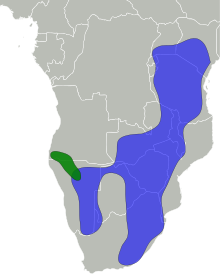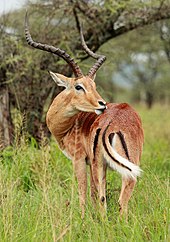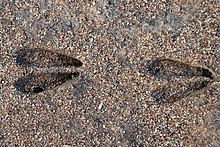Impala
| Impala | |
|---|---|

| |
| Ram in northern Botswana | |

| |
| Ewe with calf at the Kruger National Park, South Africa | |
| Scientific classification | |
| Domain: | Eukaryota |
| Kingdom: | Animalia |
| Phylum: | Chordata |
| Class: | Mammalia |
| Order: | Artiodactyla |
| Family: | Bovidae |
| Tribe: | Aepycerotini |
| Genus: | Aepyceros |
| Species: | A. melampus
|
| Binomial name | |
| Aepyceros melampus (
Lichtenstein , 1812) | |
| Subspecies | |
| |

| |
| Distribution:
Black-faced impala
Common impala | |
| Synonyms[2] | |
The impala or rooibok (Aepyceros melampus) is a medium-sized
are 45–92 cm (18–36 in) long.Active mainly
The impala is found in woodlands and sometimes on the interface (
Etymology
The first attested English name, in 1802, was palla or pallah, from the
The
Taxonomy and evolution
The impala is the
| |||||||||||||||||||||||||||||||||||||||||||||||||||||||
Up to six subspecies have been described, although only two are generally recognised on the basis of mitochondrial data.[12] Though morphologically similar,[13] the subspecies show a significant genetic distance between them, and no hybrids between them have been reported.[13][14]
- A. m. melampus Lichtenstein, 1812: Known as the common impala, it occurs across eastern and southern Africa. The range extends from central Kenya to South Africa and westward into southeastern Angola.
- A. m. petersi Bocage, 1879: Known as the black-faced impala, it is restricted to southwestern Africa, occurring in northwestern Namibia and southwestern Angola.
According to Vrba, the impala evolved from an alcelaphine ancestor. She noted that while this ancestor has diverged at least 18 times into various morphologically different forms, the impala has continued in its basic form for at least five million years.[9][15] Several fossil species have been discovered, including A. datoadeni from the Pliocene of Ethiopia.[16] The oldest fossil discovered suggests its ancient ancestors were slightly smaller than the modern form, but otherwise very similar in all aspects to the latter. This implies that the impala has efficiently adapted to its environment since prehistoric times. Its gregarious nature, variety in diet, positive population trend, defence against ticks and symbiotic relationship with the tick-feeding oxpeckers could have played a role in preventing major changes in morphology and behaviour.[9]
Description

The impala is a medium-sized, slender-bodied antelope, comparable to the kob, puku and Grant's gazelle in size and build.[17] The head-and-body length is around 130 centimetres (51 in).[18] Males reach approximately 75–92 cm (30–36 in) at the shoulder, while females are 70–85 cm (28–33 in) tall. Males typically weigh 53–76 kilograms (117–168 lb) and females 40–53 kg (88–117 lb). Sexually dimorphic, females are hornless and smaller than males. Males grow slender, lyre-shaped horns 45–92 cm (18–36 in) long.[17] The horns, strongly ridged and divergent, are circular in section and hollow at the base. Their arch-like structure allows interlocking of horns, which helps a male throw off his opponent during fights; horns also protect the skull from damage.[13][17]
The glossy coat of the impala shows two-tone colouration – the reddish brown back and the tan flanks; these are in sharp contrast to the white underbelly. Facial features include white rings around the eyes and a light chin and snout. The ears, 17 cm (6.7 in) long, are tipped with black.[13][19] Black streaks run from the buttocks to the upper hindlegs. The bushy white tail, 30 cm (12 in) long, features a solid black stripe along the midline.[19] The impala's colouration bears a strong resemblance to the gerenuk, which has shorter horns and lacks the black thigh stripes of the impala.[13] The impala has scent glands covered by a black tuft of hair on the hindlegs. 2-Methylbutanoic Acid and 2-Nonanone have been identified from this gland.[20] Sebaceous glands concentrated on the forehead and dispersed on the torso of dominant males[17][21] are most active during the mating season, while those of females are only partially developed and do not undergo seasonal changes.[22] There are four nipples.[17]
Of the subspecies, the black-faced impala is significantly larger and darker than the common impala; melanism is responsible for the black colouration.[23] Distinctive of the black-faced impala is a dark stripe, on either side of the nose, that runs upward to the eyes and thins as it reaches the forehead.[18][19] Other differences include the larger black tip on the ear, and a bushier and nearly 30% longer tail in the black-faced impala.[13]
The impala has a special dental arrangement on the front lower jaw similar to the
Ecology and behaviour

The impala is diurnal (active mainly during the day), though activity tends to cease during the hot midday hours; they feed and rest at night.[17] Three distinct social groups can be observed – the territorial males, bachelor herds and female herds.[26] The territorial males hold territories where they may form harems of females; territories are demarcated with urine and faeces and defended against juvenile or male intruders.[17] Bachelor herds tend to be small, with less than 30 members. Individuals maintain distances of 2.5–3 m (8.2–9.8 ft) from one another; while young and old males may interact, middle-aged males generally avoid one another except to spar. Female herds vary in size from 6 to 100; herds occupy home ranges of 80–180 ha (200–440 acres; 0.31–0.69 sq mi). The mother–calf bond is weak, and breaks soon after weaning; juveniles leave the herds of their mothers to join other herds. Female herds tend to be loose and have no obvious leadership.[17][27] Allogrooming is an important means of social interaction in bachelor and female herds; in fact, the impala appears to be the only ungulate to display self-grooming as well as allogrooming. In allogrooming, females typically groom related impalas, while males associate with unrelated ones. Each partner grooms the other six to twelve times.[28]

Social behaviour is influenced by the climate and geography; as such, the impala are territorial at certain times of the year and gregarious at other times, and the length of these periods can vary broadly among populations. For instance, populations in southern Africa display territorial behaviour only during the few months of the rut, whereas in eastern African populations, territoriality is relatively minimal despite a protracted mating season. Moreover, territorial males often tolerate bachelors, and may even alternate between bachelorhood and territoriality at different times of the year. A study of impala in the Serengeti National Park showed that in 94% of the males, territoriality was observed for less than four months.[17]
The impala is an important prey species for Africa's large
Parasites

Common ixodid ticks collected from impala include Amblyomma hebraeum, Boophilus decoloratus, Hyalomma marginatum, Ixodes cavipalpus, Rhipicephalus appendiculatus and R. evertsi.[32][33][34] In Zimbabwe, heavy infestation by ticks such as R. appendiculatus has proved to be a major cause behind the high mortality of ungulates, as they can lead to tick paralysis. Impala have special adaptations for grooming, such as their characteristic dental arrangement, to manage ticks before they engorge; however, the extensive grooming needed to keep the tick load under control involves the risk of dehydration during summer, lower vigilance against predators and gradual wearing out of the teeth. A study showed that impala adjust the time devoted to grooming and the number of grooming bouts according to the seasonal prevalence of ticks.[32]
Impala are symbiotically related to
Lice recorded from impala include Damalinia aepycerus, D. elongata, Linognathus aepycerus and L. nevilli; in a study, ivermectin (a medication against parasites) was found to have an effect on Boophilus decoloratus and Linognathus species, though not on Damalinia species.[39] In a study of impala in South Africa, the number of worms in juveniles showed an increase with age, reaching a peak when impala turned a year old. This study recorded worms of genera such as Cooperia, Cooperoides, Fasciola, Gongylonema. Haemonchus, Impalaia, Longistrongylus and Trichostrongylus; some of these showed seasonal variations in density.[40]
Impala show high frequency of
Diet

Impala
Impala feed on soft and nutritious grasses such as Digitaria macroblephara; tough, tall grasses, such as Heteropogon contortus and Themeda triandra, are typically avoided.[47] Impala on the periphery of the herds are generally more vigilant against predators than those feeding in the centre; a foraging individual will try to defend the patch it is feeding on by lowering its head.[48] A study revealed that time spent in foraging reaches a maximum of 75.5% of the day in the late dry season, decreases through the rainy season, and is minimal in the early dry season (57.8%).[49]
Reproduction
Males are
Rutting males fight over dominance, often giving out noisy roars and chasing one another; they walk stiffly and display their neck and horns. Males desist from feeding and allogrooming during the rut, probably to devote more time to garnering females in oestrus;[51] the male checks the female's urine to ensure that she is in oestrus.[52][51] On coming across such a female, the excited male begins the courtship by pursuing her, keeping a distance of 3–5 metres (9.8–16.4 ft) from her. The male flicks his tongue and may nod vigorously; the female allows him to lick her vulva, and holds her tail to one side. The male tries mounting the female, holding his head high and clasping her sides with his forelegs. Mounting attempts may be repeated every few seconds to every minute or two. The male loses interest in the female after the first copulation, though she is still active and can mate with other males.[17][26]
Gestation lasts six to seven months. Births generally occur in the midday; the female will isolate herself from the herd when labour pain begins.[53] The perception that females can delay giving birth for an additional month if conditions are harsh may however not be realistic.[54] A single calf is born, and is immediately concealed in cover for the first few weeks of its birth. The fawn then joins a nursery group within its mother's herd. Calves are suckled for four to six months; young males, forced out of the group, join bachelor herds, while females may stay back.[17]
Distribution and habitat

The impala inhabits woodlands due to its preference for shade; it can also be found on the interface (ecotone) between woodlands and savannahs. Places near water sources are preferred. In southern Africa, populations tend to be associated with
The historical range of the impala – spanning across southern and eastern Africa – has remained intact to a great extent, although it has disappeared from a few places, such as Burundi. The range extends from central and southern Kenya and northeastern Uganda in the east to northern KwaZulu-Natal in the south, and westward up to Namibia and southern Angola. The black-faced impala is confined to southwestern Angola and Kaokoland in northwestern Namibia; the status of this subspecies has not been monitored since the 2000s. The common impala has a wider distribution, and has been introduced in protected areas in Gabon and across southern Africa.[1]
Threats and conservation


The
Around a quarter of the common impala populations occur in protected areas, such as the
References
- ^ . Retrieved 12 November 2021.
- ^ OCLC 62265494.
- ^ Oxford English Dictionary, 3rd edition, March 2005, s.v. pallah
- ^ Oxford English Dictionary Supp., 1933, s.v.
- ^ Oxford English Dictionary, 3rd edition, November 2010, s.v.
- ^ "Aepyceros". Merriam-Webster.com Dictionary. Retrieved 10 April 2016.
- ISBN 978-1-4054-8292-9.
- ^ Huffman, B. "Impala (Aepyceros melampus)". Ultimate Ungulate. Retrieved 10 April 2016.
- ^ OCLC 10403493.
- ^ PMID 10380679.

- S2CID 30920084.
- S2CID 23102044.
- ^ OCLC 854973585.
- PMID 16407525.

- OCLC 666957480.
- S2CID 86230742.
- ^ OCLC 19554262.
- ^ OCLC 24702472.
- ^ OCLC 46643659.
- .
- OCLC 229311414.
- S2CID 3127722.
- OCLC 895661132.
- .
- OCLC 37480533.
- ^ .
- S2CID 24117010.
- S2CID 53165208.
- ^ "Impala: Aepyceros melampus". National Geographic. 11 April 2010. Archived from the original on 7 February 2010. Retrieved 6 May 2014.
- ^ OCLC 39045218.
- OCLC 48864096.
- ^ S2CID 53185353. Archived from the original(PDF) on 12 October 2016.
- PMID 7177586.
- ^ Mikula P, Hadrava J, Albrecht T, Tryjanowski P. (2018) Large-scale assessment of commensalistic–mutualistic associations between African birds and herbivorous mammals using internet photos. PeerJ 6:e4520 https://doi.org/10.7717/peerj.4520
- ^ Hussain Kanchwala (2022). "How Did We Start Drinking Milk Of The Ruminants? Are We The Only Species To Drink Milk Of Other Species?". ScienceABC.
- PMID 6689430.
- PMID 572950.
- ^ PMID 27262917.
- PMID 8372423.
- ^ OCLC 62703884.
- ISSN 0379-4369.
- .
- .
- ^ OCLC 29118101.
- S2CID 11796268.
- .
- PMID 5078117.
- ^ .
- ^ Hart, Lynette A., and Benjamin L. Hart. "Species-specific patterns of urine investigation and flehmen in Grant's gazelle (Gazella granti), Thomson's gazelle (G. thomsoni), impala (Aepyceros melampus), and eland (Taurotragus oryx)." Journal of Comparative Psychology 101.4 (1987): 299.
- OCLC 5638565.
- ^ D'Araujo, Shaun (20 November 2016). "Can Impala Really Delay Their Births?". Londolozi Blog.
- S2CID 84372708.
- . Retrieved 12 November 2021.
- S2CID 85717262.
- .
- OCLC 44634423.

